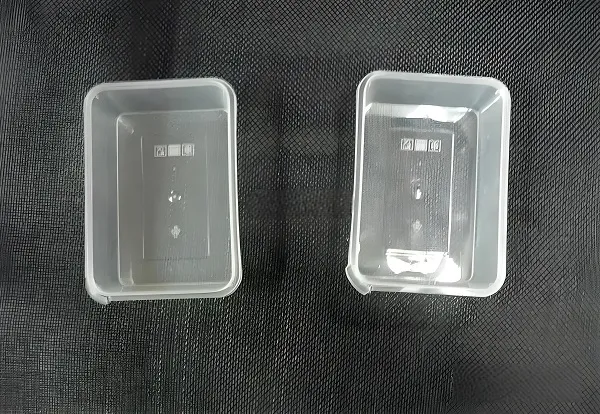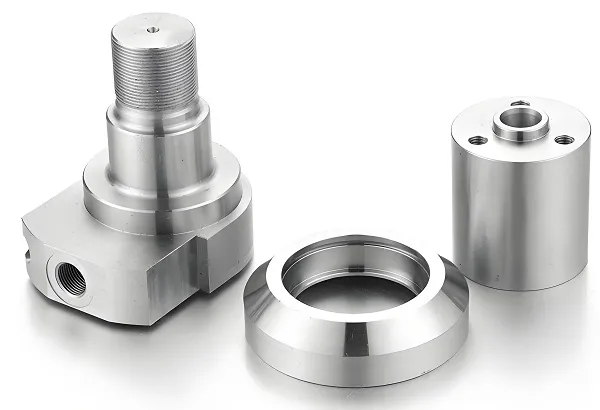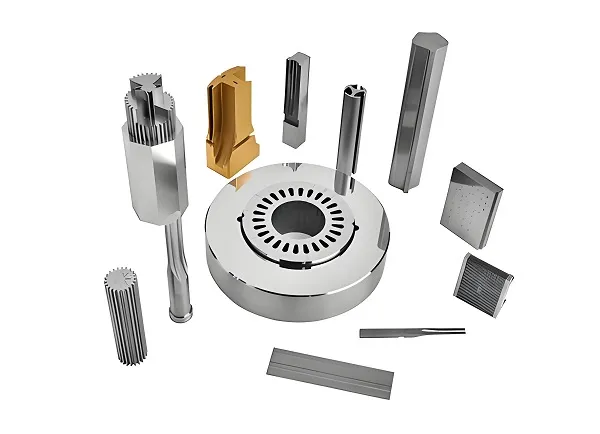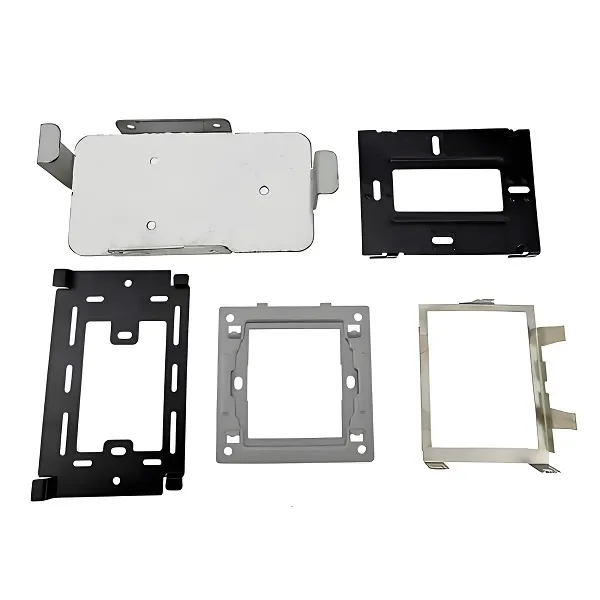CNC (Computer Numerical Control) machining, with its high precision, high repeatability, and the ability to handle complex geometries, is widely used in the manufacturing of various precision parts. Common materials include metals such as aluminum, brass, copper, steel, and titanium, as well as woods, foams, fiberglass, and plastics like polypropylene, ABS, POM, PC, and nylon.

Common CNC Precision Part Machining:
-
Aerospace
- Engine components: Turbine blades, combustion chamber nozzles, compressor disks.
- Structural components: Aircraft wing ribs, landing gear axles, missile casings.
- Hydraulic systems: Precision valve bodies, high – precision connectors.
-
Medical and Biotechnology
- Implants: Artificial joints (acetabular cups, knee joints), dental implants, spinal screws.
- Surgical instruments: Endoscope parts, minimally invasive surgical forceps, bone drills.
- Medical equipment: Insulin pump housings, pacemaker casings.
-
Automotive Industry
- Power systems: Fuel injector nozzles, transmission gears, crankshafts.
- Chassis components: Steering knuckles, brake calipers, suspension links.
- New energy vehicles: Battery cooling plates, motor housings, precision parts of charging interfaces.
-
Electronics and Semiconductors
- Heat dissipation devices: Copper/aluminum heat fins, liquid – cooled plates.
- Connectors: High – speed communication interfaces (USB – C, HDMI), RF coaxial connectors.
- Wafer equipment: Vacuum chambers, fixtures, probe cards.
-
Optics and Precision Instruments
- Optical components: Lens barrels, laser mirror brackets, fiber optic couplers.
- Measuring instruments: CMM probes, sensor housings, precision gears.
The core advantages of CNC machining are ultra – high precision, with dimensional accuracy reaching IT5 level. It supports five – axis linkage for handling complex geometries, and can machine complex structures such as deep cavities, overhanging surfaces, and irregular holes. It also has a wide range of machinable materials, including metals, plastics, and composite materials.
CNC Machining of Thin – walled Parts
Thin – walled parts are prone to deformation and vibration during CNC machining due to their small wall thickness and insufficient rigidity. Especially in the machining of materials such as aluminum alloy and titanium alloy, the tiny cutting force during high – speed cutting may cause the parts to bend, have surface waviness, or dimensional deviation.
-
Fixture Design
Custom – made fixtures can reinforce the key areas of the thin – wall to reduce free vibration. At the same time, the multi – point support method can effectively disperse the clamping stress and ensure the overall stability of the part. In actual operation, the fixture design must not only be stable but also avoid interfering with the tool path to ensure smooth machining. For small or thin parts, the application of flexible fixtures or vacuum fixtures is particularly important. These fixtures can fix the workpiece while avoiding excessive local stress and causing deformation. -
Tool Selection
Since thin – walled parts are extremely likely to deform due to cutting force or vibration, short and rigid tools can significantly reduce the risk of vibration during machining. Choosing the right tool for different materials is also crucial. For example, when machining aluminum parts, coated carbide tools can be used. This not only improves the tool’s wear resistance but also reduces tool sticking and surface scratches. For thin – walled titanium parts, it is recommended to use highly wear – resistant coated tools with a lower feed rate to reduce the impact of cutting force on the thin – wall structure. -
Machining Strategy
In terms of machining strategy, the method of “roughing – finishing – layer control” should be adopted. Initial roughing removes most of the material, reduces residual stress, and creates conditions for subsequent finishing. Layer – by – layer finishing can not only control the cutting force but also reduce the deformation risk of thin – walled parts. At the same time, using a multi – axis machine tool to complete the machining in one clamping can effectively reduce the number of workpiece flips and the possibility of repeated positioning errors. In the control of specific cutting parameters, reducing the cutting depth and feed speed and optimizing the smoothness of the tool path can further reduce vibration and cutting impact.
Surface Machining of CNC Precision Machinery Parts
-
Improving the Corrosion Resistance of Parts
After CNC precision part machining, metal materials may be exposed to corrosive environments such as humidity, acids, and alkalis. Through surface treatments such as electroplating, anodizing, or spraying, a protective layer can be formed on the part surface, significantly improving its corrosion resistance and extending its service life. -
Enhancing Wear Resistance and Reducing Mechanical Wear
Parts processed by CNC are prone to wear in a long – term friction environment (such as gears, bearings). Processes such as carburizing, nitriding, or hard chromium plating can be used to increase the surface hardness, reduce the wear rate, and ensure the long – term stable operation of the parts. -
Improving Appearance and Cleanliness
Some industries (such as consumer electronics and medical devices) have extremely high requirements for the appearance of parts. Through treatments such as polishing, sandblasting, or electrochemical polishing, burrs and tool marks after CNC machining can be removed, making the surface smoother and more aesthetically pleasing. At the same time, it reduces the adhesion of pollutants and meets the high – cleanliness requirements.
Advantages of CNC Precision Part Machining
-
Firstly, CNC precision part machining has a higher work efficiency. CNC – machined parts can be processed on several surfaces. Compared with ordinary machining centers, it can save more manufacturing processes, improve efficiency, and the product quality of CNC – machined parts is also better than that of ordinary lathes, with more reliability.
-
CNC precision part machining plays an irreplaceable role in new product development. Generally, different complex – structured parts can be processed through code programming, and the modification and content update of the design only require adjusting the program code of the machining center, which can greatly shorten the development progress of new products.
-
The degree of mechanical automation of CNC precision part machining is very high, which greatly reduces the manual work intensity of operators. During the machining process, operators do not need to fully control the machine like an ordinary lathe. They mainly observe and supervise the machining center. However, the corresponding CNC machining technology is more difficult than that of ordinary lathes, so it requires technicians with higher skills.
XiaMenGoldcattle provides high – precision and high – efficiency machining services. Equipped with advanced CNC machining equipment, it can meet the customized needs of various aluminum parts, including cutting, milling, and drilling. With good technical strength and rich industry experience, it widely serves industries such as electronics, automotive, and aerospace, ensuring product quality and delivery time. In addition, we also provide design support and post – processing services to meet the diverse needs of CNC machining customers in Shunde, Foshan. Machining services: CNC 3/4/5 – axis precision machining, CNC lathe machining, rapid prototyping model processing, surface treatment processing. Machinable materials include: aluminum alloy, red copper, brass, beryllium copper, magnesium alloy, acrylic PMMA, Peek, PEI, PPO, PPS, ABS, PA nylon, PI.






